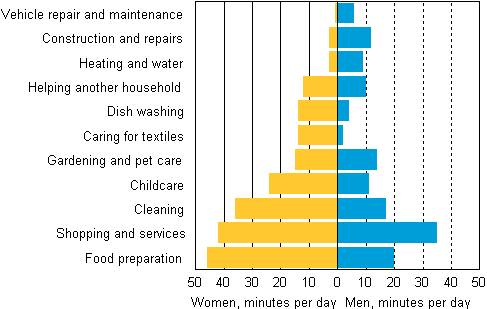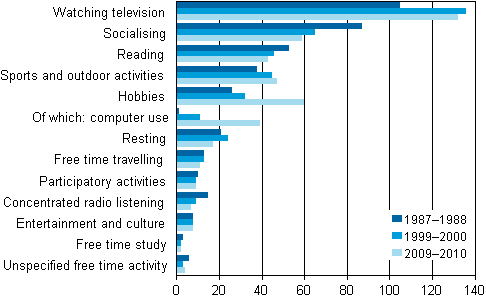Published: 15 December 2011
Women's total working time longer than men's
The difference between the time used by women and men on domestic work has narrowed down over the 2000s: women do less domestic work and men more. The total labour input formed by gainful employment and domestic work has diminished, because the time spent on gainful employment has fallen particularly among men. Women's total working time is now longer than men's. These data derive from Statistics Finland's Time Use Survey conducted in 2009.
Time used by men and women on various types of domestic work in 2009 to 2010, population aged 10 or over

Because of the economic recession, less time was used on gainful employment from 2009 to 2010 than in the two previous decades. Men did more gainful employment than women did. The difference between men and women in the amount of gainful employment diminished among wage and salary earners, but grew among self-employed persons.
The content of domestic work made by men and women has come closer to each other. However, women do the majority of housekeeping, and men do most of maintenance work.
The amount of free time has grown
The amount of free time has grown by one hour per week over the 2000s. Finns now have free time an average of 47 hours per week. Men still have more free time than women do. In the Time Use Survey, free time is the amount of time in a day that remains after time spent on sleep, meals, washing and dressing, gainful employment and domestic work, as well as on studying has been deducted.
Women have decreased watching television during the last ten years, while among men watching television has remained unchanged. Those aged 65 or over watch the most television. They also read now more than ten years ago. In all, the time spent on reading magazines and books has been falling since the late 1980s. The time spent on sports and outdoor activities and socialising has stayed the same as ten year previously.
The biggest change in free time use over the past ten years has been that computer use has become fast general. Men use the computer more than women do. The computer is used most by children and young people.
Distribution of free time in 1987–1988, 1999–2000 and 2009–2010, population aged 10 or over, minutes per day

Gainful employment is done most in autumn and least in summer. Correspondingly, domestic work is done most in summer, especially various construction and repair work, including gardening. Free time use is more home-centred in winter than in summer.
Finns now have a later daily rhythm. People go to bed clearly later today than three decades ago. On Saturdays, domestic work is begun later than in the previous decades, and outdoor activities start later than before on Sundays.
Source: Time Use Survey 2009, Statistics Finland
Inquiries: Hannu Pääkkönen (09) 1734 3229, Riitta Hanifi (09) 1734 2946, ajankaytto@stat.fi
Director in charge: Riitta Harala
- Tables
-
Tables in databases
Pick the data you need into tables, view the data as graphs, or download the data for your use.
Updated 15.12.2011
Official Statistics of Finland (OSF):
Time use [e-publication].
Time use changes through the 2000s 2009. Helsinki: Statistics Finland [referred: 5.12.2025].
Access method: http://stat.fi/til/akay/2009/05/akay_2009_05_2011-12-15_tie_001_en.html

